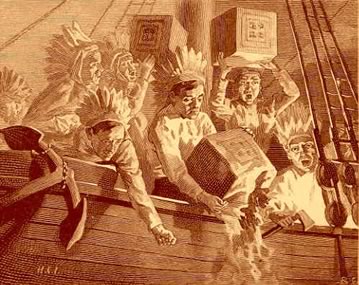
It is commonly believed that the lodge rooms of a Boston Masonic Lodge served as the dressing room for the so-called Indians who threw the Boston Tea Party.
According to The Builders by Joseph Fort Newton, the Boston Tea Party was planned, and executed by Freemasons disguised as Mohawk Indians - not by the Lodge as such, but by a club formed within the Lodge, calling itself the Caucus Pro Bono Publico. Other sources more directly link it to the Lodge meetings at the Green Dragon Tavern**.
Two thousand people stood on Griffin’s Wharf and watched the Boston Tea Party. The crowd was silent as sixty men dumped 342 chests of tea into the salt water. Some of them put lampblack or paint on their faces. Some came wrapped in blankets. They called themselves “Mohawks.” But most of the participants actually were not disguised.
What are some of the names of the famed Masons who were supposedly at that "party" or served as the leaders?
Who was there? Paul Revere, who later went on to be Grand Master of Massachusetts, was thought to be one of those Indians. John Hancock, Thomas Crafts, John Warren, all Masons, are names often heard as planners or participants. Another active group of revolutionary Patriots was the famous Sons of Liberty lead by Sam Adams, who are also said to have been involved.
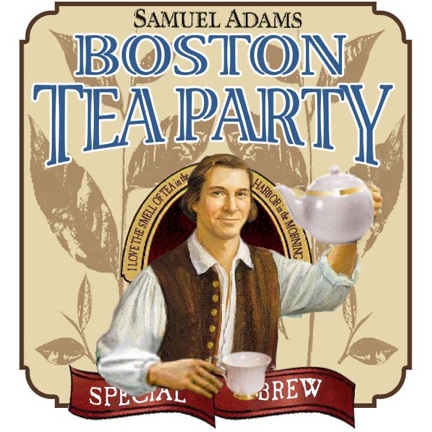
Benjamin Franklin, a Grand Master of Masons in Pennsylvania, was in London at the time (and therefore, sitting in the midst of his future enemy). Franklin, choosing his words carefully, as he often did, called the Boston Tea Party “an act of violent injustice.” He also noted, “Though the mischief was the act of persons unknown, yet as probably they cannot be found, or brought to answer for it, there seems to be some reasonable claim on the society at large in which it happened.”
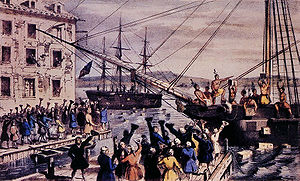
This iconic 1846 lithograph by Nathaniel Currier was entitled The Destruction of Tea at Boston Harbor, for the phrase "Boston Tea Party" had not yet become standard. Contrary to Currier's depiction, few of the men dumping the tea were actually disguised as American Indians.
There never would have been a Tea Party if the ships could have left before December 17th. Several of the Brothers of the St. Andrews Lodge did their part in trying to turn the tea ships around.
Brother William Molineux acted as spokesman for the Sons of Liberty. He and Brother Joseph Warren led a crowd of 300 from the Liberty Tree to the Customs House to confront the Consignees. Would these tea agents resign and send the tea ships back to England? The Governor’s sons refused and moved to Fort William under military protection. Just three years before Brother Molineux and Brother James Otis (St. John’s Lodge) had led a crowd of a thousand patriots to confront the Governor’s sons who were importing tea and hiding it in a warehouse against the nonimportation agreements. In that tea business, the Hutchinsons surrendered the tea and the money for the tea they had already sold. Brother James Otis was the Mason who gave us the saying “Taxation without representation is Tyranny!”.
Brother John Hancock was the Colonel for the Governor’s Cadet Corps who guarded the tea ships. The night before the Tea Party he was aboard the tea ships inspecting his troops. Both he and Brother Joseph Warren had served as Orators at the Commemoration of those who had died at the Boston Massacre.
Brother John Hancock was the richest merchant in New England. He served as Moderator for a mass Town Meeting of 5,000 who voted to turn the tea ships around. He was a member of the Committee of Selectmen, who were the leading tradesmen of Boston, who met with the Governor and the tea Consignees to try to convince them to let the ships go.
Brother John Rowe was the owner of one of the tea ships, the Eleanor. He was also a Selectman and promised to use his influence with the Governor to return the tea ships and the tea to England. Brothel Rowe was the Grand Master of the St. John’s Grand Lodge of Massachusetts (Moderns). In his diary he called the dumping of the tea “a disastrous affair.”
Brother Edward Cair, Southern Calilornia Research Lodge, Masonic World.
No one ever paid for the tea. Parliament took the tax off tea, but the East India Tea Company was never able to sell tea in America.
No trial of the “Mohawks” ever occurred in Boston or anywhere else. Governor Thomas Hutchinson said that if he held a trial in Boston the members of the jury would turn out to be the “Mohawks” or their friends. After the Boston Tea Party, Governor Hutchinson was replaced by General Gage in April 1774, and some felt Hutchinson had been (in modern jargon) "disappeared." Actually, driven from the country by threats in May 1774, and broken in health and spirit, Hutchinson spent the rest of his life an exile in England, dying in 1780.
Meanwhile, the Boston Tea Party showed the resistance of the Patriots, as carefully planned by Masonic elements. Soon, the American Revolution came, and today, most Americans drink coffee. And, in Boston, Sam Adams beer.
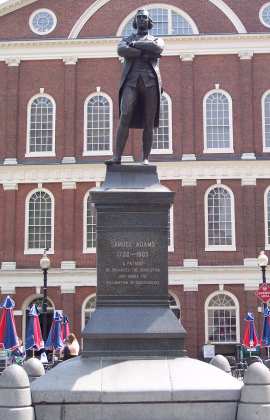
A statute of Sam Adams stands today at Faneuil Hall, Boston.
*The Boston Tea Party Copycat Effect: The Boston Tea Party has often been referenced in other political protests, as for example in the "tea parties" of 2009.
Historically, there have been other examples. When Mohandas K. Gandhi led a mass burning of Indian registration cards in South Africa in 1908, a British newspaper compared the event to the Boston Tea Party. When Gandhi met with the British viceroy in 1930 after the Indian salt protest campaign, Gandhi took some duty-free salt from his shawl and said, with a smile, that the salt was "to remind us of the famous Boston Tea Party."
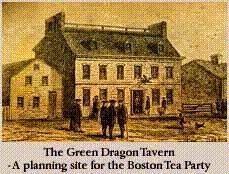
**Tavern Footnote:
The Green Dragon Tavern was a public house used as a tavern and meeting place located on Union Street in Boston's North End.
It was purchased in 1764 by the St. Andrews Lodge of Freemasons for its 1st floor meeting rooms. The basement tavern was used by several secret groups and became known by historians as the "Headquarters of the Revolution." The Sons of Liberty (headed by Sam Adams), the Boston Committee of Correspondence and the North End Caucus each met there. The Boston Tea Party was planned there and Paul Revere was sent from there to Lexington on his famous ride. In January 1788, a meeting of the mechanics and artisans of Boston passed a series of resolutions urging the importance of adopting the Federal Constitution pending at the time before a convention of delegates from around Massachusetts. The building was demolished in 1854.
The current Green Dragon Tavern is located on 11 Marshall Street in Boston's North End. Its publicity states that it is the "headquarters of the revolution," though its relationship to the demolished original pub is not immediately apparent and perhaps not significantly important. That the symbolism to be found in the name is carried on is perhaps the meaning in the message here.
Sources:
Boston Tea Party Historical Society; Boston Tea Party-Wikipedia; Masonic Line; Masonic Topics: USA; and Masonic World.
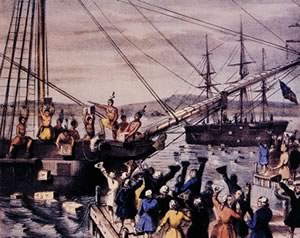 .
.It's Tax Day in America. My best to everyone going through this yearly spring ritual here. If you have an extra $10 left over, please know that amount from you builds to what we need to save the museum. Do remember to...
:-) Thank You.
At exactly noon EDT, CNN was running a story with Mary Snow on remote at a Tea Party protest.
ReplyDeleteBefore the story was fully explored Mary Snow was interrupted by President Obama's talk on TAXATION (and the subjective tax changes he's made).
And synchromagically I began reading your article at the very same moment (11 am CDT/12pm EDT) that CNN began its report on the 700 or so Tea Parties taking place across the nation on my TV.
Excellent background, thanks!
~SE~